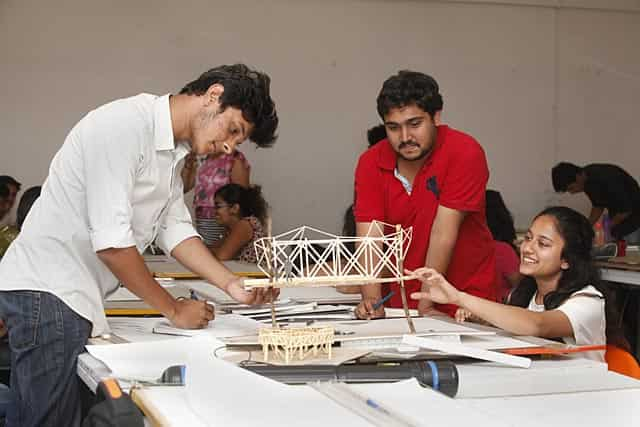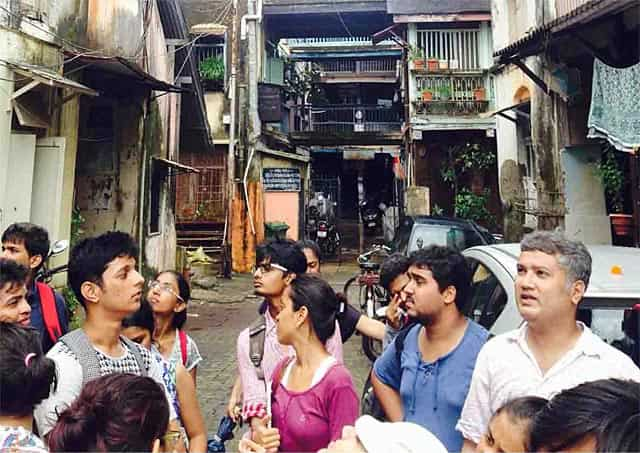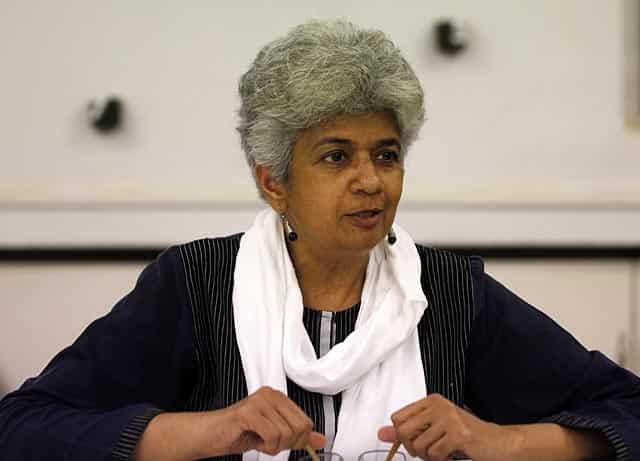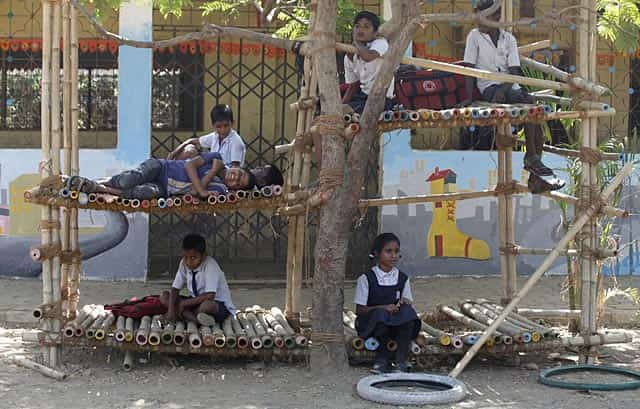An architecture school in Mumbai
From Shivaji memorials to slum development, community housing to highrises, a new school of architecture helmed by architects from Mumbai and Delhi is bringing culture and community back into the classroom.
Till the Eighties when Hindi cinema was still interested in the lives of ordinary people, a rented apartment, or the lack of it, led to plot complications with romantic quarrels and compromises. If a couple did manage a flat, they would give you at least one happy song on the balcony. In the Nineties, builder-driven housing became a Mumbai reality. Those with money began to climb up concrete and steel towers for security, sea-views, 24/7 power-backup and water supply. Those who couldn't, burst a vessel each time another modest building fell in the shadow of a highrise. They also witnessed a city convulsing under the dismantling of its mills and factories, a huge population of workers left behind without work; the mafia's trial runs, and the rise of the architect's profession that, strangely enough, remained neutral to those upheavals to continue to build first-world buildings next to third-world ones.


Highrises and vertical slums are side by side in Mumbai with different civic amenities.
A group of architects, educationists and town planners -- pass-outs or former faculty of traditional architecture schools such as the School of Planning and Architecture, Delhi, or Academy of Architecture and the JJ School of Architecture in Mumbai -- did not make peace with this. The linkages between people, politics, culture and structures had to be an important part of pedagogy, they felt. Six months ago they started SEA (School of Environment and Architecture) in Borivli, offering a bachelor's course, in a joint venture with the Suvidya Prasarak Sangh (SPS) -- a 40-year-old trust run by a Seventies' cooperative of middle-class Maharashtrians -- open to the idea of an education that would link it to current debates of urban living.
Collage city
The architecture of Mumbai is a mix of Gothic, Victorian, Art Deco, Indo-Saracenic and contemporary architectural styles.
There are 21 different house types used in Mumbai. These include fishing village houses, colonial government buildings, wadis (set of buildings with shops in the front and houses behind and on higher floors), chawls, private apartments of the 70s and 80s; public sector employee housing, slums, dilapidated building redevelopments.
Population of Mumbai (metropolitan area): 20.5 million; 62% of its population live in slums. Despite its growth over the past 20 years, Mumbai has recorded its slowest population growth in nearly a century.
Data: World Population Review, SEA
SEA seems to draw much of its pragmatic spirit from this tie-up and its neighbourhood. Groceries, stationery and hardware shops, clockmakers, small-time house brokers, carpenters are its neighbours in this northwest Mumbai suburb. The school towers over no one; the locality looks into its compound; the gate is near invisible. SM Pendse, a retired government employee and an SPS trustee, said they gave the space of their four-storey school to house SEA as land was a key social issue for Mumbai, and "their values matched ours".
Aditya Panchal, a student with the experience of community living in a chawl, recalls that in class, when he said he wanted to make the world's tallest building, "I was asked by my teachers to consider why I didn't want to make the world's happiest building." During his field trip to Murbad, a tribal village closeby, he realised why it was more than just a good line. "In a tribal village, the community owns the land. But property means having one clear owner. We didn't think of community needs before that. In this school, we don't just study how to make a brick wall; we work with bricks to understand their weight, saw wood to make doors. During the entrance exam, they judged us by how we well we knew a street." The school is no 'alternative,' say its teachers. Rather, it is an experiment to see if they can bring the city into the school, and whether an academic curriculum can provoke new thinking about the city.
School of Environment and Architecture students during class.
In his book 'History, Culture and the Indian City', labour historian Rajnarayan Chandavarkar had pointed out how middle and upper-class Mumbai's modernising ambitions " rested lightly over the appalling living conditions of the poor," glorifying the cliché of the poor and rich living cheek-by-jowl in social harmony. In a city of over 20 million people with over 60% residing in slums and the division of civic amenities drawn up on the basis of wealth, will this 'harmony' one day crack? Associate professor Prasad Shetty says it's time students prepare for a future where their client may be a rickshawpuller, a man from the Inner Cities (the areas from where Bombay began) or a low-income migrant. Architects have to stop being white-collar if they have to find work, he says. His students have, in fact, just completed a 'Bamboo Cube,' a play space, for a neighbourhood municipal school.
"Mumbai has no good policy on repairs or retrofitting. Another myth is that Mumbai does not have land. Slums occupy just 8% of its land area. Why can't we think of improving them instead of pulling them down or not work with land with multiple claims on them?" asks Shetty. "It is so easy to be an architect in New York, where systems are in place. What students here need to learn is how to work where there are problems, how to transact with the ground."

Prasad Shetty with students during a field tour in a low-income colony in Mumbai. (Photo courtesy: School of Environment and Architecture)
These are important questions to ask in and out of the classroom at a time when Mumbai is debating its new Development Plan, that housing experts say, may allow slum land to be taken over for commercial development while being silent on affordable housing. At SEA, what planner and principal Ravi Punde, Neera Adarkar, an urbanist who has worked with Mumbai's mill workers, conservation architect Pankaj Joshi, Shetty, among others, seem to be encouraging is a way of seeing, a dismantling of old ideas and a daily questioning of their own practice as architects. An architecture curriculum, they say, should encourage students to consider the city as a place for all kinds of business and commerce, but also inculcate in students a respect for public spaces and the right of all classes to them. In SEA classes, Dharavi, not surprisingly, is talked of as a neighbourhood -- not a slum -- that is buzzing with enterprise, selling packet breakfast, made-in-two-hour denim and leather jackets, and these days, with a 'Dharavi Biennale' to boot.
Researching the city
Anuj Daga, an alumni of Yale University, who joined the faculty, says he was attracted by its space for debate and research. At the moment the school is running two parallel programmes - SEA-Conversations, a discussion forum on issues relevant to the city, and Emerging Practices, which encourages initiatives new emerging architects are taking in their practices, to promote them.

"Mumbai's design schools prepared draughtsmen who finished facades. Public space was not part of their pedagogy": Neera Adarkar, urbanist.
Culture, in fact, is a subject the faculty throws open, rather than teach, in the classroom. "Is a Shivaji memorial in the middle of the sea good for the city?", "Will there be environmental hazards?", "Is he remembered because he was a man with a standing army?", "Which group is backing the project and why?" , "Who is opposing and why?". The open-endedness of the discussions, however, does make one wonder what students make of this and other topics that are discussed. But to let students decide where they stand as they come up against life and its experiences, is perhaps what the best of teachers do.

The Bamboo Cube made for the playground of a municipal school by students.
On Hafeez 'Highrise' Contractor, another famous Maharashtrian, whose name is synonymous with real-estate development in the city, the verdict at SEA is fractured, and good-humoured.
"Hafeez has hijacked the imagination of what architecture is in the city."
"Hafeez is jokingly called the Elevation Man."
"Hafeez is important."
"But not as important as Shivaji…"
Between the imperious vertical reality of the city and the democratic horizontality of intentions of a bunch of its architect-citizens, there can only be so much open space, though. Discussions on Shivaji and Mr Contractor, notwithstanding.





